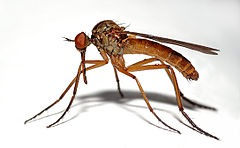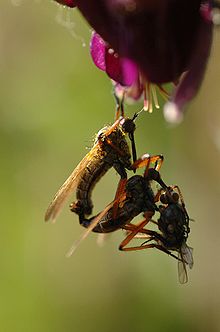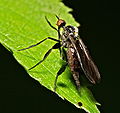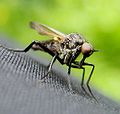- Empididae
-
Dagger flies and balloon flies
Temporal range: Cretaceous - Recent
Male Empis livida Scientific classification Kingdom: Animalia Phylum: Arthropoda Class: Insecta Order: Diptera Suborder: Brachycera Infraorder: Asilomorpha Superfamily: Empidoidea Family: Empididae Subfamilies Brachystomatinae
Ceratomerinae
Clinocerinae
Empidinae
Hemerodromiinae
Oreogetoninae
TrichopezinaeEmpididae is a family of flies with over 3,000 described species occurring worldwide, but the majority are found in the Holarctic. They are mainly predatory flies like most of their relatives in the Empidoidea, and exhibit a wide range of forms but are generally small to medium sized, non-metallic and rather bristly.
Common names for members of this family are dagger flies (referring to the sharp piercing mouthparts of some species) and balloon flies. The term "dance flies" is sometimes used for this family too, but the dance flies proper, formerly included herein, are now considered a separate family Hybotidae.
Some Empididae, such as the European species Hilara maura, have an elaborate courtship ritual in which the male wraps a prey item in silk and presents it to the female to stimulate copulation. Empidid larvae are also largely predatory (although some are scavengers) and occupy a wide range of habitats, both aquatic and terrestrial.
Evolution and systematics
Empididae are well represented in amber deposits and the family certainly seems to have been well established by the Cretaceous period at the latest.
Two groups formerly placed here as subfamilies are now generally regarded as separate families in the Empidoidea: Atelestidae and Hybotidae. The Brachystomatidae are also sometimes separated as a distinct family, but this seems to be in error. The Microphorinae were long placed in the Empididae as a subfamily, then briefly classified as a distinct family, and are now considered a subfamily of the long-legged flies (Dolichopodidae).[1]
Among the subfamilies currently placed herein, not all are confirmed to be monophyletic groups. Some rearrangements, in particular regarding the delimitation of Empididae versus Dolichopodidae – which together represent the bulk and the most advanced lineages of the Empidoidea – are likely to take place in the future. The Brachystomatinae, Empidinae and Hemerodromiinae however seem to be natural groups of closest relatives in their entirety, and the Clinocerinae apparently are for the largest part.[2]
Gallery
Footnotes
References
- Chinery, Michael (1986): Collins Guide to the Insects of Britain and Western Europe.
- Moulton, J.K. & Wiegmann, B.M. (2007): The phylogenetic relationships of flies in the superfamily Empidoidea (Insecta: Diptera). Mol. Phylogenet. Evol. 43(3): 701-713. doi:10.1016/j.ympev.2007.02.029 (HTML abstract)
- Sinclair, B.J. & Cumming, J.M. (2006): The morphology, higher-level phylogeny and classification of the Empidoidea (Diptera). Zootaxa 1180: 1-172. PDF fulltext
External links
Categories:- Empididae
- Insect families
Wikimedia Foundation. 2010.















